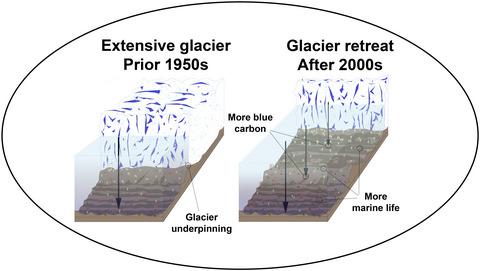当前位置:
X-MOL 学术
›
Glob. Change Biol.
›
论文详情
Our official English website, www.x-mol.net, welcomes your feedback! (Note: you will need to create a separate account there.)
Blue carbon gains from glacial retreat along Antarctic fjords: What should we expect?
Global Change Biology ( IF 11.6 ) Pub Date : 2020-03-23 , DOI: 10.1111/gcb.15055 David K A Barnes 1 , Chester J Sands 1 , Alison Cook 2 , Floyd Howard 1 , Alejandro Roman Gonzalez 3 , Carlos Muñoz-Ramirez 4, 5 , Kate Retallick 6 , James Scourse 3 , Katrien Van Landeghem 6 , Nadescha Zwerschke 1
Global Change Biology ( IF 11.6 ) Pub Date : 2020-03-23 , DOI: 10.1111/gcb.15055 David K A Barnes 1 , Chester J Sands 1 , Alison Cook 2 , Floyd Howard 1 , Alejandro Roman Gonzalez 3 , Carlos Muñoz-Ramirez 4, 5 , Kate Retallick 6 , James Scourse 3 , Katrien Van Landeghem 6 , Nadescha Zwerschke 1
Affiliation

|
Rising atmospheric CO2 is intensifying climate change but it is also driving global and particularly polar greening. However, most blue carbon sinks (that held by marine organisms) are shrinking, which is important as these are hotspots of genuine carbon sequestration. Polar blue carbon increases with losses of marine ice over high latitude continental shelf areas. Marine ice (sea ice, ice shelf and glacier retreat) losses generate a valuable negative feedback on climate change. Blue carbon change with sea ice and ice shelf losses has been estimated, but not how blue carbon responds to glacier retreat along fjords. We derive a testable estimate of glacier retreat driven blue carbon gains by investigating three fjords in the West Antarctic Peninsula (WAP). We started by multiplying ~40 year mean glacier retreat rates by the number of retreating WAP fjords and their time of exposure. We multiplied this area by regional zoobenthic carbon means from existing datasets to suggest that WAP fjords generate 3,130 tonnes of new zoobenthic carbon per year (t zC/year) and sequester >780 t zC/year. We tested this by capture and analysis of 204 high resolution seabed images along emerging WAP fjords. Biota within these images were identified to density per 13 functional groups. Mean stored carbon per individual was assigned from literature values to give a stored zoobenthic Carbon per area, which was multiplied up by area of fjord exposed over time, which increased the estimate to 4,536 t zC/year. The purpose of this study was to establish a testable estimate of blue carbon change caused by glacier retreat along Antarctic fjords and thus to establish its relative importance compared to polar and other carbon sinks.
中文翻译:

沿南极峡湾冰川退缩获得的蓝碳:我们应该期待什么?
大气中二氧化碳的增加正在加剧气候变化,但它也正在推动全球尤其是极地绿化。但是,大多数蓝色碳汇(由海洋生物持有)正在缩小,这一点很重要,因为它们是真正的碳固存的热点。在高纬度大陆架地区,北极蓝碳随着海冰的损失而增加。海洋冰(海冰,冰架和冰川退缩)的损失对气候变化产生了宝贵的负面反馈。据估计,随着海冰和冰架损失,蓝碳的变化,但是蓝碳对峡湾冰川退缩的反应方式却没有。通过调查西南极半岛(WAP)的三个峡湾,我们得出了一个可撤消的冰川退缩驱动的蓝碳收益的估计值。我们首先将约40年的冰川退缩率乘以退缩WAP峡湾的数量及其暴露时间。我们将该区域乘以现有数据集中的区域性底栖动物碳均值,以表明WAP峡湾每年产生3,130吨新的底栖动物碳(t zC /年)和螯合> 780 t zC /年。我们通过捕获和分析新兴WAP峡湾中204幅高分辨率海底图像对这一点进行了测试。这些图像中的生物群被确定为每13个官能团的密度。从文献值中分配了每个人的平均储碳量,得出每个区域的兽底碳储量,将其乘以随时间暴露的峡湾面积,将估计数增加到4,536 t zC /年。
更新日期:2020-04-22
中文翻译:

沿南极峡湾冰川退缩获得的蓝碳:我们应该期待什么?
大气中二氧化碳的增加正在加剧气候变化,但它也正在推动全球尤其是极地绿化。但是,大多数蓝色碳汇(由海洋生物持有)正在缩小,这一点很重要,因为它们是真正的碳固存的热点。在高纬度大陆架地区,北极蓝碳随着海冰的损失而增加。海洋冰(海冰,冰架和冰川退缩)的损失对气候变化产生了宝贵的负面反馈。据估计,随着海冰和冰架损失,蓝碳的变化,但是蓝碳对峡湾冰川退缩的反应方式却没有。通过调查西南极半岛(WAP)的三个峡湾,我们得出了一个可撤消的冰川退缩驱动的蓝碳收益的估计值。我们首先将约40年的冰川退缩率乘以退缩WAP峡湾的数量及其暴露时间。我们将该区域乘以现有数据集中的区域性底栖动物碳均值,以表明WAP峡湾每年产生3,130吨新的底栖动物碳(t zC /年)和螯合> 780 t zC /年。我们通过捕获和分析新兴WAP峡湾中204幅高分辨率海底图像对这一点进行了测试。这些图像中的生物群被确定为每13个官能团的密度。从文献值中分配了每个人的平均储碳量,得出每个区域的兽底碳储量,将其乘以随时间暴露的峡湾面积,将估计数增加到4,536 t zC /年。



























 京公网安备 11010802027423号
京公网安备 11010802027423号